A&S Linguistics Students Bring Scholarship into the Community
In Professor Amanda Brown’s Linguistics at Work class, students produced demos to teach people of all ages in Central New York about linguistics and language acquisition, processing and use.
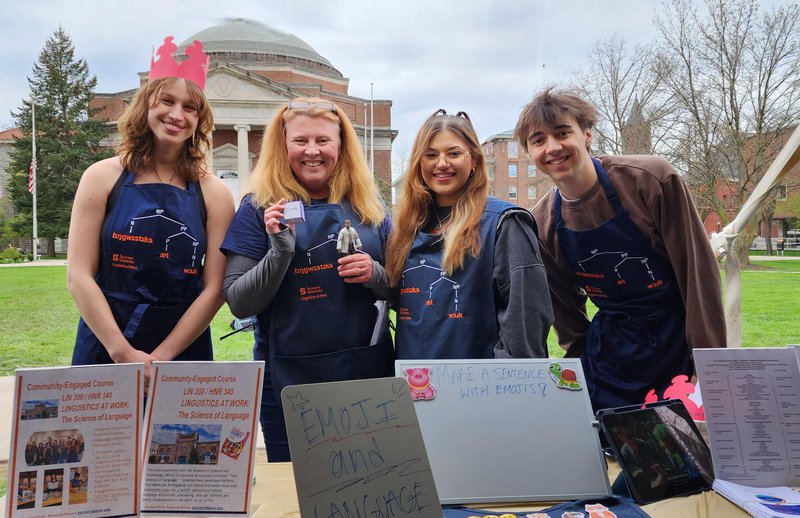
Professor Amanda Brown (second from left) was joined by students from her Linguistics at Work class, including (from left to right) Kori Teresi, Natalie Naranjo and Jolon Watson, at the annual Department of Languages, Literatures and Linguistics' Cultures on the Quad event. Students shared their interactive demos at various community events throughout the spring semester.
Students enrolled in linguistics courses typically learn about languages and how they are structured, inter-related, processed, enacted and acquired. In Professor Amanda Brown’s LIN 300/HNR 340: Linguistics at Work, they not only explored this type of disciplinary subject matter, but also tapped into skills such as engineering, marketing and community engagement. In this course, which took place during the Spring 2024 semester, students partnered with the Milton J. Rubenstein Museum of Science and Technology (MoST) in Syracuse on a project entitled, “The Science of Language.” They developed interactive demos that showcased the scientific phenomena behind language acquisition, processing and use.
This was one of five classes that made up the inaugural Engaged Courses cohort through the College of Arts and Sciences’ Engaged Humanities Network (EHN). The aim of this program is to elevate and interconnect the work happening in new and existing A&S classes whose curriculums empower students to forge meaningful community partnerships through their coursework.
The Motivation
Brown drew inspiration for LIN 300 from the work of Laura Wagner, professor of psychology at the Ohio State University, who developed a language-linguistics lab embedded as a permanent exhibit in the Center for Science and Industry (CoSI) in Columbus, Ohio. With funding from SU’s inaugural Faculty Creative Activities and Research (FCAR) program, Brown and fellow LLL professor Emma Ticio traveled to Ohio to meet Wagner and visit the CoSI “Labs in Life” exhibition. After gaining invaluable advice from Wagner about how to develop a course based around experiential learning and community engagement, Brown returned to Syracuse and shared her ideas for a linguistics demo with Emily Stewart, senior director of education and curator at the MoST, who welcomed the collaboration.
Semester Snapshot
When the semester began, Brown introduced students to Wagner and Cecile McKee’s textbook “How to Talk Language Science with Everybody.” This offered a blueprint of how to adapt their content into interactive public demonstrations to participants of different ages, abilities and levels of interest.
While they read about various demo possibilities in the course text and practiced them in class, Brown was thrilled when many of the students decided to create original demos based upon their own research interests.

Beyond brainstorming their demos and engaging with the disciplinary course content, students gained myriad transferable skills through this class.
“They learned about marketing, specifically how to select and describe scientific linguistics phenomena with an eye towards public appeal, and to sell their content to a stakeholder,” says Brown. “They explored engineering, physically creating their demos within constraints such as the materials available and the need for feasibility and durability.”
In addition, students also developed proficiency in public speaking through their pitches to the MoST; interactive public engagement when adapting and delivering their content to a general audience; and job readiness from their discussions with Kristen Aust and Donna McLellan from A&S Career Advising, who offered advice on how to document their skills and experiences to employers.
A Look at their Community Work
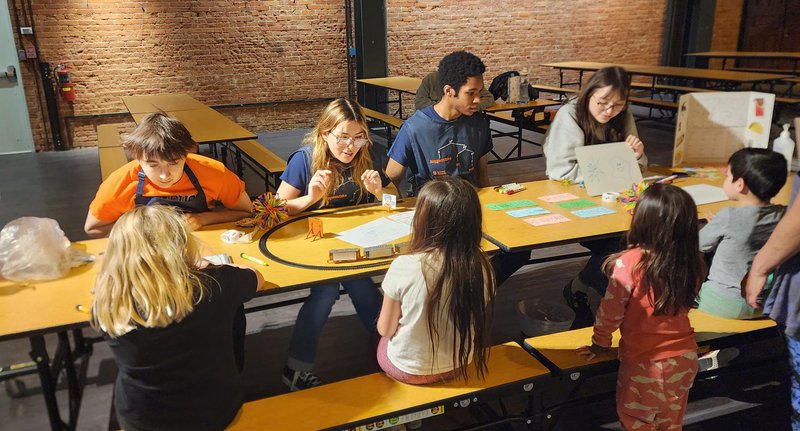
Linguistics students engaged with children around their demos at the MoST.

Ethan Davis’s demo asked participants to play with word parts to make a new secret language, akin to the “Verlan” slang used in France.

Wendy Qiu’s demo involved the origins of words (e.g. labyrinth) in Greek mythology with associated stories to read and puzzles to play.
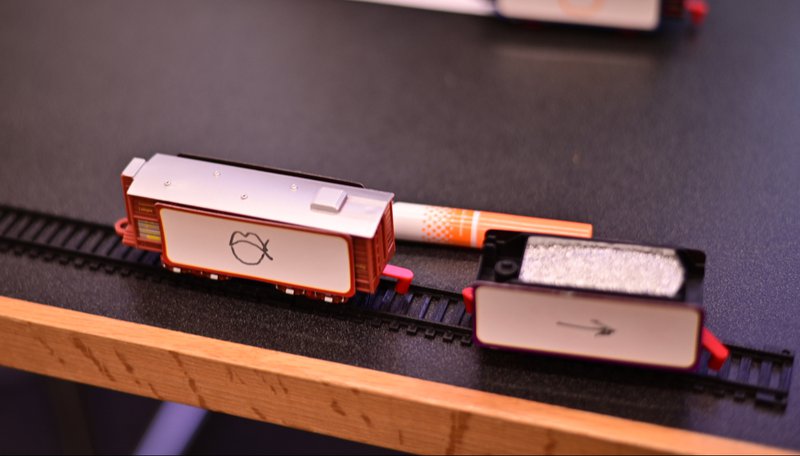
Rosalia Avila’s demo employed a train with stops on a track to illustrate the various processes involved in the production of speech or sign, from concept through lexicalization to construction of a sentence. (Photo credit: Kenji Oda)
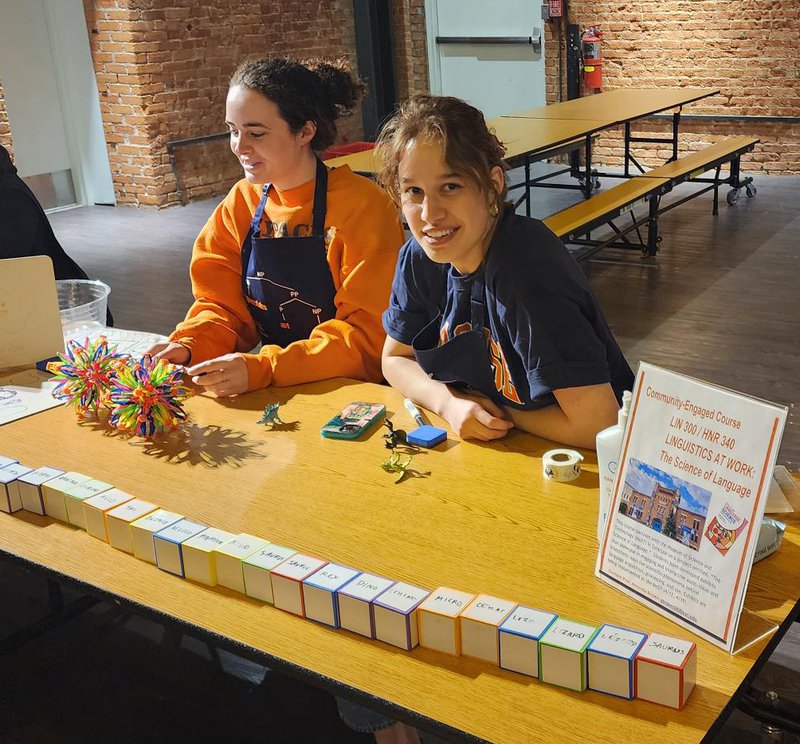
Paige Emerson’s (left) demo asked participants to label round and spiky toys as “kiki” or “bouba”, demonstrating that some word meanings are not arbitrary and illustrating connections between specific speech sounds and visual shapes. Kori Teresi’s (right) dinosaur-morphology game involved creating dinosaur names from word parts and learning the meanings of those parts, such as Tyranno-saurus rex, meaning ‘tyrant-lizard king.’
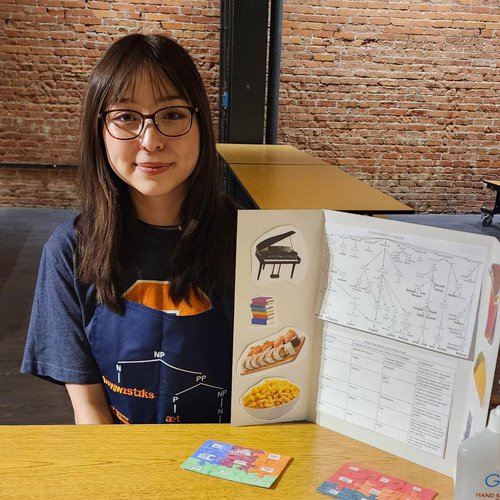
“Through these demos, participants of any age could see linguistics as a science; could appreciate the language they use so naturally every day as more complex and rule-governed than they may ever have thought; could witness both the similarities and differences among diverse languages that showcase our commonalities and uniqueness; and could experience the creativity and excitement of our talented and community-engaged students,” notes Brown.
The semester concluded with a presentation at the Engaged Humanities Network Showcase, where Brown and students from the Linguistics at Work class joined other Syracuse University teams to share their publicly-engaged projects.

A&S students (from left) Kimberlyn Lopez Herrera, Miya Barbuto and Alex Dacanay, from Professor Amanda Brown’s Linguistics at Work course, talked about their demos at the EHN showcase.
While this was the first trial run for this course, Brown says as the name “Linguistics at Work” implies, it can be adapted to a range of contexts where the discipline can contribute to professional contexts and public good. With the positive reception to this year’s “Science of Language” project, she’s hopeful to offer a similar opportunity soon.
“I think we created something of value that is hard to measure but will remain in memory – for each of us but also for the participants with whom we interacted – potentially for a long time,” concludes Brown. “I think everyone was very pleased with the outcome, so you may see a group of people wearing blue aprons with Linguistics at Work embroidered in orange and carrying model dinosaurs, dry erase boards, and magnetic emojis around campus and the wider community next year.”
